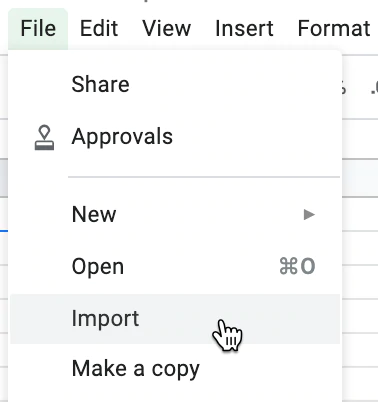How to create CSVs
This section provides you with some general guidance on using CSV files. If you have experience with CSV files you may skip this section.
CSV Basics
What is a CSV file?
CSV stands for comma-separated values, a file format (.csv) for spreadsheets. CSV files are simple data documents in which each record is separated by commas. Because of their small file size, they can be useful when importing or updating a large amount of customer records.
You can open and edit CSV files in spreadsheet software such as Google Sheets or Microsoft Excel. When opened in this software, the document is formatted into columns. The first row - header row- contains the information pertaining to the rest of the data in the file. Every following row is a record for the data that you are working with.
Your CSV files must use:
- UTF-8 encoding
- Comma
,delimited
How to get started
When working with CSV files with Ophelos, you have two choices:
- Use a template (recommended): Download the appropriate CSV file here and open the file with your preferred spreadsheet software.
- Start from scratch: start from an empty CSV file and use our formatting guides to fill it in.
Using spreadsheet softwares
Google Sheets
Import CSV file
Steps:
- Log into your Google account
- On the Google Sheets page, click Blank in the Start a new spreadsheet section.
- From the Untitled Spreadsheet page, go to File > Import...

- Locate and select the CSV file that you want to edit.
- In the Import file dialog, select your preferred options under the Import action, Separator character, and Convert text to numbers and dates sections.
- Click Import.
From here you can edit your CSV. When you are done, you can export it from Google Sheets as a .csv file.
Export CSV file
When you are done viewing or editing your CSV file in Google Sheets, you can export it as a .csv file to your computer.
Steps:
- From your CSV spreadsheet page, go to File > Download > Comma-separated values (.csv, current sheet).
- Your CSV file is exported to your downloads folder.
When uploading the CVS file in our dashboard, your file’s name must look like:
- For placement files:
YYYYMMDD-placement.csve.g.20210811-placement.csv- For transaction files:
YYYYMMDD-transaction.csve.g.20210811-transaction.csv- For arrangement files:
YYYYMMDD-arrangement.csve.g.20210811-arrangement.csv- For closure files:
YYYYMMDD-closure.csve.g.20210811-closure.csv
Microsoft Excel
Opening and Editing CSV file
Steps:
- Open Microsoft Excel
- Go to File > Open and locate your file and double click on it
- Excel will automatically display the data in column format
From here you can edit your CSV. When you are done, you can save your file and Excel will update it.
Export CSV file
If you are starting from a new file, instead of saving your document as a excel file (.xls or .xlsx) you should save it as a .csv file:
Steps:
- In Excel go to File > Save As
- Go to the location you wish to save you file in
- In File Format select: CSV DOS (.csv)
- Your CSV file is exported to that location
When uploading the CVS file in our dashboard, your file’s name must look like:
- For placement files:
YYYYMMDD-placement.csve.g.20210811-placement.csv- For transaction files:
YYYYMMDD-transaction.csve.g.20210811-transaction.csv- For arrangement files:
YYYYMMDD-arrangement.csve.g.20210811-arrangement.csv- For closure files:
YYYYMMDD-closure.csve.g.20210811-closure.csv
Updated 10 months ago
